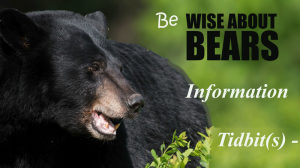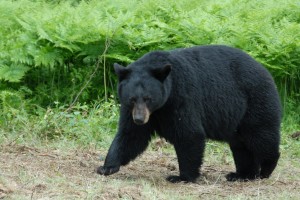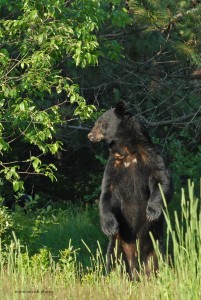Living and recreating in areas where there may be bears?
Its a Bear! What do I do?
 “Young bears (sub adults) are often unwary, naive and curious. They are more likely to come close to humans. Black bears rarely pose a threat to humans. The noisier the bear is, the less dangerous it is. These are all warning signals bears give to let you know you are too close. Do not approach the bear. When bears are caught off guard, they are stressed, so back away slowly. A bear usually runs away.” – Mike McIntosh
“Young bears (sub adults) are often unwary, naive and curious. They are more likely to come close to humans. Black bears rarely pose a threat to humans. The noisier the bear is, the less dangerous it is. These are all warning signals bears give to let you know you are too close. Do not approach the bear. When bears are caught off guard, they are stressed, so back away slowly. A bear usually runs away.” – Mike McIntosh
Interactions Between Humans and Black Bears.

Interactions between humans and black bears are most likely to occur near what a bear identifies as a food source. The frequency of such encounters depends on a number of factors:
• how much natural food is currently available to bears
• how much natural food was available to bears in the previous summer and fall.
• the proportion of the bear population that consists of yearling and two-year-old bears (which will peak one or two years following highly successful reproductive years).
Yearlings and two-year-olds wander widely as they disperse from the area where they were born. They are often unwary and naive and are more likely to come into contact with humans.
• whether bears have ready access to human garbage
• availability of agricultural and horticultural crops
• seasonal human behaviour that brings people into contact with bears
(e.g. encounters will increase when people begin to arrive at cottages and campgrounds).
In the majority of situations, black bears pose no threat to humans, but there are several factors that may affect perceived or real dangers in those situations.
Its a Bear! What do I do?
If you by chance encounter a black bear it may:
- Stand on its hind legs to get a better look at you
- Salivate excessively, exhale loudly, and make huffing, moaning, clacking and popping sounds with its mouth, teeth and jaws
- Lower its head with its ears drawn back while facing you
- Charge forward, and/or swat the ground with its paws. This is also known as a bluff charge
Note: 1-A bear exhibiting the above described behaviors is asking you to leave the area. This type of behavior rarely, if ever, results in the bear attacking. We should not consider this to be dangerous or aggressive, but rather assertive behavior or nervous behavior. 2 – If you have a dog(s) with you, keep your dog(s) on a leash. Unleashed dogs have been known to aggravate a bear and cause an attack to dog(s) and people – Mike McIntosh
What to do – Surprise and Close Encounters:
- Remain calm. Do not run. Stand still and talk to the bear in a calm voice
- If you are equipped – arm your pepper spray
- Do not try to get closer to the bear
- If the bear does not get closer to you, slowly back away, talking to the bear in a quiet, monotone voice. Do not scream, turn your back on the bear, run or kneel down.
- Watch the bear and wait for it to leave
- If the bear does not leave or approaches you, yell and wave your arms to make yourself look bigger. Throw objects, blow a whistle or an air horn. The idea is to persuade the bear to leave
- If you are with others, stay together and act as a group. Make sure the bear has a clear escape route
- If the bear keeps advancing, and is getting close, stand your ground. Use your bear pepper spray (if the bear is within seven metres) or anything else you can find or use to threaten or distract the bear
- Do not run or climb a tree
Video – A Safe and Effective Way to Scare a Bear
Credits – text: Ontario Ministry of Natural Resources except where noted.
Photos, Video: Mike McIntosh / Bear With Us.
